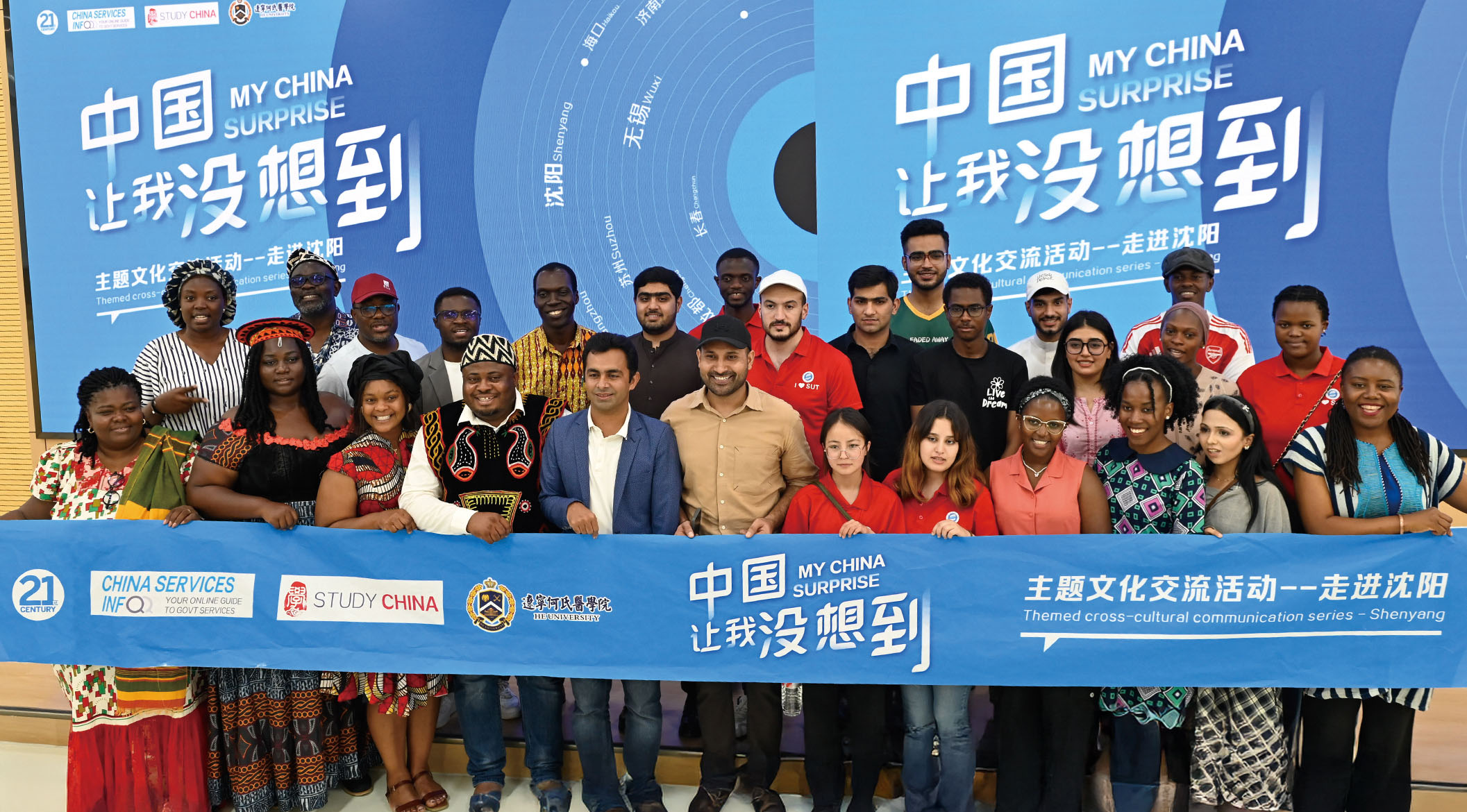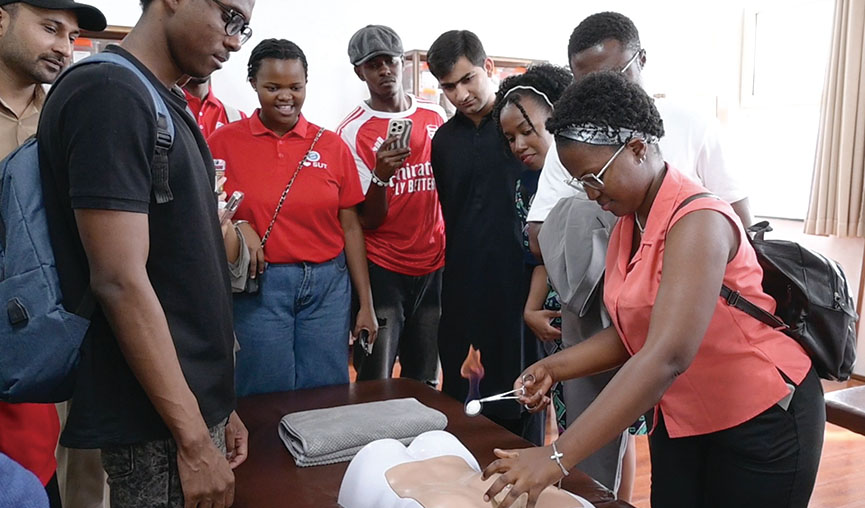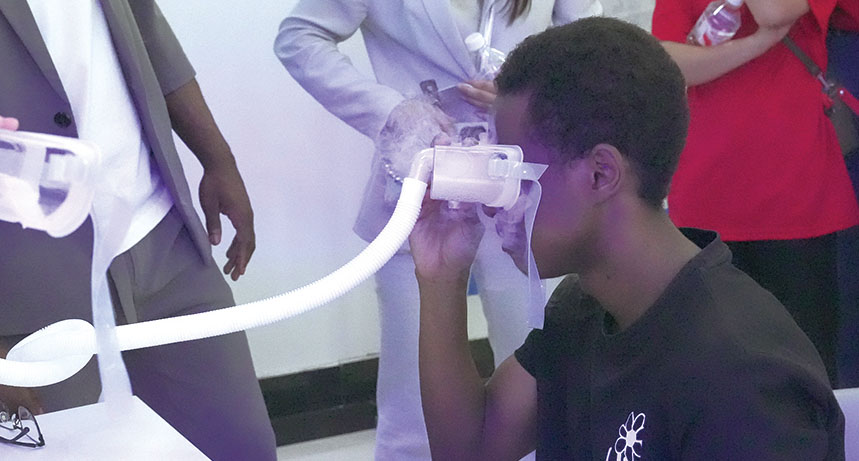From TCM to high-tech diagnostics, students gain hands-on experience that blends China's medical heritage with modern innovation.

The soft hum of an eye nebulization device filled the room as Hamna Jahangir from Pakistan leaned forward, letting the therapeutic vapor soothe her eyes.
"My eyes felt dry before, but now they're so comfortable," she said. "In my country, eye treatment mainly relies on drops. Devices like this are rare."
At the Eye Gene Bank of Liaoning He University, 22 international students from Africa, Asia, and the Middle East explored China's medical education. From ocular nebulizers and visual simulation devices to gene testing and traditional therapies, each facility offered a new perspective on the possibilities of modern medicine.
Jahangir, a clinical medicine major at Shenyang Medical College, noticed a stark contrast with Pakistan's "diagnose and prescribe" approach.
"Doctors back home rely heavily on experience, and hospital equipment is basic," she said. "This nebulization device showed me the power of technology for preventive care, rather than simply reacting when problems worsen. It made me rethink what truly effective healthcare means."
READ MORE: A night market of healing
For Hussein Abdulbaqi Hussein Al-Tameemi from Iraq, the visit was equally eye-opening.
At the university's Clinical Skills Training Center, he performed CPR on a high-fidelity manikin for the first time. He was amazed as the manikin's chest rose naturally with each compression while the monitor displayed real-time vital signs.
"In Iraq, medical education is mostly theoretical, with few opportunities for hands-on practice. We just memorized CPR steps from textbooks," he said. "Today, I realized how much strength and rhythm it actually takes. The instant feedback helped me correct mistakes within minutes."
In the research laboratory of the Eye Gene Bank, students gathered around an aquarium, watching zebrafish dart through the water — tiny creatures making outsize contributions to human ophthalmology research.
"Zebrafish have eye structures similar to humans and short life cycles, which makes them ideal for experiments," the instructor explained.
For Muisha Bienvenue Mbikyo, a PhD student from the Democratic Republic of the Congo at China Medical University, this research method held particular significance.
"In Africa, the cost of research is a major challenge," he said. "Zebrafish experiments show that innovation comes from creativity, not expensive equipment."
He studied every stage of the zebrafish experiment in detail — from gene modification and drug testing to data collection and analysis.
"I'm exploring how to apply this approach to cardiovascular research because zebrafish hearts develop similarly to human hearts," he said. "If we can build comparable models, it could greatly help prevent and treat heart disease in Africa."

Healing across cultures
Traditional Chinese medicine (TCM) also left a strong impression on the students. Edwin Msabila from Tanzania admitted he had once been skeptical of traditional treatments. But after trying cupping therapy at the university's cupping therapy station and observing how negative pressure affects the skin while listening about meridian theory, his perspective changed.
"I began to understand the physiological mechanism behind it: negative pressure improves local blood circulation and tissue metabolism," he said. "The key is whether a treatment is effective, not whether it's traditional or modern."
Seth Nkrumah from Ghana, a student at Liaoning University of Traditional Chinese Medicine, shared how he applied TCM in his home country during the COVID-19 pandemic, helping over 200 patients.
"I brought 4,000 acupuncture needles and moxa sticks, and they were all used up in just over three months," he said. "That experience showed me that TCM is not just Chinese medicine — it can benefit people across cultures."
At the Clinical Skills Training Center, students took turns practicing a wide range of medical techniques — from emergency care and surgical suturing to medical record writing and patient communication. Each step was guided by professionals who provided real-time feedback.
Even for Qurat ul Ain from Pakistan, a non-medical student at Liaoning University, the experience offered valuable insights into education itself.
"Regardless of one's major, practical experience is essential," she said. "Theoretical knowledge only becomes meaningful when applied to solve real-world problems."

During an afternoon seminar, discussions turned to the broader significance of cross-cultural medical exchange.
Mbikyo explained that his choice to study medicine in China was motivated not only by the country's advanced technology but also by its educational philosophy. "China emphasizes benevolence in medicine and values the doctor-patient relationship," he said. "That's very similar to our traditional healing beliefs in Africa. Medicine is not just about skills — it's about compassion and responsibility."
Nkrumah said the day's experiences reaffirmed his belief that medicine knows no borders. "Whether it's modern medical equipment or traditional therapies, the goal is the same — to ease suffering and protect human health," he said. "Our mission as international students is to bring these valuable medical ideas and technologies to the world."
The students' discussion became especially animated when they explored how to turn their experiences into future action. "When I return to Iraq, I hope to help establish a similar clinical training center," Al-Tameemi said. "Even with limited resources, we can start small and gradually build a stronger practical training system."
ALSO READ: Global rise of TCM
Founded by Professor He Wei, the He Eye Specialist Hospital, Liaoning He University, and the He Eye Industry Group have developed a comprehensive eye health ecosystem. Through international cooperation and training programs, they have shared a sustainable "China Eye Health Model", supporting doctors and health managers across Asia, Africa, and Latin America.
Ding Weiguang, executive vice president of Liaoning He University, emphasized that the school will continue to leverage the full breadth of He's eye health ecosystem to accelerate international talent training and strengthen global collaboration.
"We aim to cultivate outstanding talents who combine patriotism with a global perspective and to contribute wisdom and strength to serving national strategies and building a community with a shared future for mankind," he said.
Liu Shicheng contributed to this story.
Contact the writers at wuyong@chinadaily.com.cn


